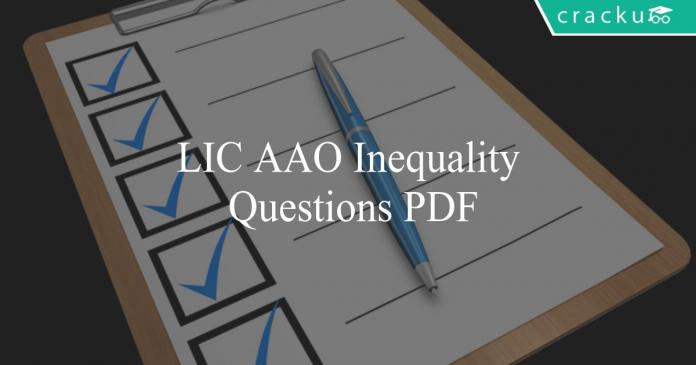LIC AAO Inequality Questions PDF
Download Important Inequality questions for LIC AAO exam. Top 10 Inequality questions with answers based on previous year asked questions.
Download LIC AAO Inequality Questions PDF
Take a free mock test for LIC AAO
Download LIC AAO Previous Papers PDF
Instructions
Choose which of the conclusion(s) follow(s) based on the statements given:
Question 1: $ R = S$; $Q \geq P$; $S < T$; $ T > Q$;
Conclusions:
I: $ T \geq P$
II: $ R \leq Q$
a) Only conclusion I is true.
b) Only conclusion II is true.
c) Either conclusion I or conclusion II is true.
d) Both the conclusions are true.
e) Neither of the conclusions is true.
Question 2: Statements:
$A>C$; $B \leq D$; $E \geq A$; $D > E$;
Conclusions:
I:$ B \leq A$
II: $ D > C$
a) Only conclusion I is true.
b) Only conclusion II is true.
c) Either conclusion I or conclusion II is true.
d) Both the conclusions are true.
e) Neither of the conclusions is true.
Question 3: Statements:
$P \leq Q$; $S > R$; $ R<P$
Conclusions:
I: $R < Q$;
II: $P> S$;
a) Only conclusion I is true.
b) Only conclusion II is true.
c) Either conclusion I or conclusion II is true.
d) Both the conclusions are true.
e) Neither of the conclusions is true.
Download LIC AAO Previous Papers PDF
100 Free Computer Awareness Tests for LIC
Question 4: For which of the following options, the conclusion $F \leq D$ will be definitely false?
a) $ F= E \leq B \leq A \leq D$
b) $ F= E \leq B \geq A \leq D$
c) $ F= E \geq B > A \geq D$
d) $ F= E > B \leq A\leq D$
e) More than one of the above
Question 5: For which of the following options, the conclusions $A\geq B$ and $C < D$ will definitely hold true?
a) $D > A \geq E = C \geq B$
b) $D > A \geq E < C < B$
c) $ D \geq A = E < C > B$
d) $ D \geq A > E > C = B$
e) $ D \leq A > E < C = B$
Question 6: Select the option that will fill the blanks such that the conclusion $P \leq Q$ is definitely false:
P_____A_____R_____F_____Q
a) $ =, \leq , \leq, = $
b) $ = , \geq, = , >$
c) $ \geq, \leq, = ,>$
d) $ >, > , < , =$
e) $ \geq, =, <, \geq$
Question 7: Select the option that will fill the blanks such that the conclusion $D<A$ is definitely true.
A ____ C _____ B____ E_____D
a) $= , \geq, = , \leq$
b) $=, \geq, >, =$
c) $\geq, \geq, \leq, >$
d) $\geq , >, \geq, =$
e) More than one of the above
100 Free GK Tests for Insurance Exams
Instructions
In the next five questions, the values some elements are compared in the statement. Two conclusions are given after every statement. Assuming the statement to be true, you have to determine which of the conclusions are implied by the statement.
Question 8: $ A > B < C = D > E; E > F \geq G < H$
Conclusion I: $A < G$
Conclusion II: $ B > F$
a) Only conclusion I is implied
b) Only conclusion II is implied
c) Both the conclusions are implied
d) Neither conclusion I nor II is implied
e) Either I or II is implied
Question 9: $ G > H \leq I = J; J > K < L$
Conclusion I: $G > L$
Conclusion II: $ H < K$
a) Only conclusion I is implied
b) Only conclusion II is implied
c) Both the conclusions are implied
d) Neither conclusion I nor II is implied
e) Either I or II is implied
Question 10: which of the following values satisfy the inequality ?
P (P-3) < 4P- 12 ?
a) p>4 or p<3
b) 4<=P<7
c) P>3,P<=5
d) 3
e) P=4,P=-3
LIC AAO REASONING QUESTIONS PDF
Answers & Solutions:
1) Answer (E)
The given statements can be combined as $R = S < T > Q \geq P$.
$T$ is greater than $Q$. Therefore, $T$ is definitely greater than $P$. Conclusion I is false since it states that $T \geq P$.
No relationship can be established between $R$ and $Q$ since there is a change in the sign of the inequality. Therefore, conclusion II does not follow.
Neither of the conclusions follow. Therefore, option E is the right answer.
2) Answer (B)
The given statements can be combined as $ B \leq D > E \geq A > C$.
As we can see, $ D > C$ and no relationship can be established between $B$ and $A$ due to the change in the inequality. Therefore, only conclusion II follows and hence, option B is the right answer.
3) Answer (A)
The given statements can be combined as $S > R < P \leq Q$. As we can see, no relationship can be established between $P$ and $S$ as there is a change in the inequality. Also, we can see that $R$ is less than $Q$.
Only conclusion I follows and hence, option A is the right answer.
4) Answer (C)
First, let us eliminate the options in which there is a change in the direction of the inequality between F and D. We can eliminate option B and option D using this case.
Now, let us check options A and C.
Option A:
$ F= E \leq B \leq A \leq D$
From this option, we can conclude that $ F\leq D$. Therefore, the statement $F \leq D$ is definitely true. We can eliminate option A.
Option C:
$ F= E \geq B > A \geq D$
We can conclude that $F> D$. Therefore, the conclusion $F \leq D$ is definitely false in this case. Therefore, option C is the right answer.
5) Answer (A)
Any option in which there is a change of sign between A and B or C and D will render the terms unrelatable. Therefore, let us first eliminate such choices.
Except options A and D, all other options involve a change in the inequality. Therefore, we can eliminate options B, C and E.
Option A:
$D > A \geq E = C \geq B$
Both the conclusions $A \geq B$ and $C<D$ hold true in this case.
Option D:
$ D \geq A > E > C = B$
The conclusion $C<D$ is true but the conclusion $A \geq B$ is false in this option. Therefore, we can eliminate option D.
Therefore, option A is the right answer.
6) Answer (B)
P and Q are at the either ends of the inequality. If there is an inconsistency in the sign (like change from > to < in between), no relationship can be established between P and Q. Therefore, we can eliminate options C, D and E.
Let us check options A and B.
Option A:
$P = A \leq R \leq F =Q$
We can say that $P \leq Q$ from this relation. Therefore, option A can be eliminated.
Option B:
$P = A \geq R = F > Q$
We can say with conviction that $ P > Q$.Therefore, the conclusion $P\leqQ$ will be definitely false in this case. Therefore, option B is the right answer.
7) Answer (E)
We can easily eliminate the options in which there is a change in the direction of the inequality between A and D, since no relationship can be established in such cases. This eliminates options A and C. Let us check options B and D.
Option B:
$A= C \geq B> E = D$
In this option, the conclusion $D<A$ is definitely true.
Option D:
$A\geq C > B\geq E = D$
In option D too, the conclusion $D<A$ is definitely true.
The conclusion $D<A$ is true for both options B and D. Therefore, option E is the right answer.
8) Answer (D)
The given statement is
$ A > B < C = D > E; E > F \geq G < H$
B is less than C and E is also less than C. Hence we cannot compare B and E.
Since only ‘E’ is common between the first and the second parts of the inequality, we cannot compare B with any of the terms from the second part. Hence conclusion II is not implied.
Similarly no relation can be established between A and G and thus we cannot comment about which one is greater among K and Q. Thus conclusion I is also not implied. Hence the correct answer is option D.
9) Answer (D)
The given inequality is
$ G > H \leq I = J; J > K < L$
G is greater than H and I is greater than or equal to H. Hence we cannot compare G and I. Thus, we cannot compare G and H also. Since H is the only term which is common between the first and the second term, we cannot compare G and L. Thus, I is not implied.
H is less than or equal to I which is equal to J. So H is less than or equal to J. Now K is also less than J. Hence we cannot say anything about the relationship between H and K.
Thus, II is also not implied. Hence option D is the correct answer.
10) Answer (A)
Expression : $P(P-3)<4P-12$
=> $P^2-3P-4P+12<0$
=> $P^2-7P+12<0$
=> $(P-3)(P-4)<0$
=> $P<3$ and $P>4$
=> Ans – (A)





